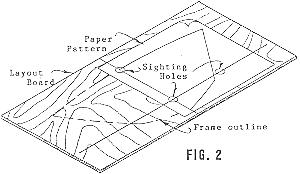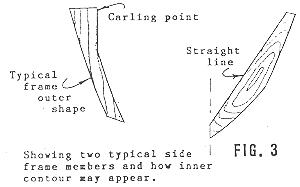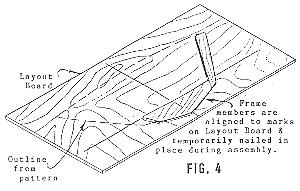

How to Use Full Size Patterns
One of two types of patterns may be furnished with your Plans and Patterns package; one type is printed or blueprinted while the other type is drawn out from master templates on heavy kraft paper. On smaller boats, the blueprinted patterns may have both the inner and outer contour given, while on the larger boats the pattern will show only the outer contour. Patterns on all but the smallest boats are given in half section; meaning only one half is shown. In some cases, a pattern may be superimposed on another, and to distinguish each frame or member, you may wish to use colored pencils to delineate the lines being used. All reference lines, such as centerline, set-up level, or waterline are indicated on the patterns. The patterns given for the particular boat are as noted in the GLEN-L catalog under the description of the plan purchased.
DO NOT CUT THE PATTERNS OUT - SEE THE FOLLOWING
Frames
Frames may consist of a dozen or more parts and it is extremely difficult to hold these parts in position when assembling over a paper pattern, so the following system was developed. Read and understand the methods described before starting construction.

Fig. 1 - The LAYOUT BOARD (a sheet or sheets of plywood, aluminum or steel depending on the construction method) as large as the biggest full width frame of the boat is laid on a flat surface. Usually this can be the plywood used for the transom and other parts. A vertical line, representing the frame centerline, is drawn on the Layout Board. At right angles (90o) to the centerline, draw a horizontal line that represents the reference line on the patterns, either waterline or setup level. Adjust the height of this horizontal line so that all frame outlines will lay within the limits of the Layout Board.

Fig. 2 - Half section frame patterns are aligned over the centerline and horizontal reference line marked on the Layout Board. To "see" through the paper, cut sighting holes in the paper pattern on each end of the centerline and reference line to align the frame pattern centerline and reference line to the lines on the Layout Board underneath, holding the pattern to the Layout Board with weights or thumb tacks. The outer contour of the frame is then transferred to the Layout Board using carbon paper, or by pricking through the pattern at frequent intervals with an awl or tracing wheel (such as used in dressmaking). If the former, use two pieces of carbon paper, one carbon side to the Layout Board and the other carbon side to the paper pattern, to duplicate the lines to the UNDERSIDE of the paper pattern and on the plywood simultaneously. Mark through the pattern with a hard pencil, tracing the outer frame outline. The entire outline need not be scribed to the Layout Board, only the pertinent areas so the wooden part can be positioned accurately. With either the carbon paper or pin prick, be sure the centerline and horizontal reference line are duplicated to the UNDERSIDE of the paper pattern. Continue, flip the paper pattern over to the opposite side of the centerline and mark the frame contour to the Layout Board for the other half of the frame. The entire exterior outline of the frame, or the portions required, should now be indicated on the Layout Board. Each frame can be laid out in similar manner or each can be assembled prior to marking the subsequent one to avoid a confusion of lines.

Fig. 3 - Use the pattern to mark the outer contour of the frame member, side, bottom, gussets, etc. to the wood. In some smaller boats, the inner and outer contour of the frame members may be given on the pattern, and, if so, mark on the lumber. In most boats, the inner contour is not critical except where noted, such as height of floor timbers or bottom frame members, or carling position. The contour of the inner frame members may be straight lines or moulded the width specified in the plans or instructions. The section drawings in the plans will indicate the general contour of the frame members and the extremities of plywood gussets. Always cut duplicate parts at the same time; a frame may have four or more gussets, so tack the plywood together and cut simultaneously. To duplicate half section deck beams to a full width, draw a reference line on the pattern at 90 o to the pattern centerline, extending through the sheer point. Align the paper pattern reference line to a straight line on the wood the beam is to be cut from, and transfer the arc contour on each side of the centerline similarly to that done for the frame pattern.

Fig. 4 - After all frame parts have been cut, align the members to the frame contour drawn on the Layout Board. Temporarily nail the frame to the Layout Board; a frame may have more than a dozen parts and attempting to leave them loose or hold them during assembly is impractical and will lead to inaccurate frames.
Transom
If the edges of the transom require an angle, review the patterns carefully before making any cuts. The layout is made directly on the plywood to be used for the transom by the same method used to transfer the frame contours to the Layout Board (See FRAMES). The transom contour is usually given to the outside back surface of the transom with any angles cut away from, or larger than this shape. However, check the plans and patterns for precise information. Rough cut the plywood transom to the maximum size required allowing for the angle. Temporarily fasten the oversize, rough cut, inner frame on the unmarked side of the transom plywood, leaving the edge projecting over the plywood to allow for the angle. Tack additional doublers in place if required, then saw the assembled transom and frame to the required angle. The frame can then be removed, inner contour and notches cut, and then glued and fastened to the transom as described in the plans.
Other parts
Using the patterns for stems, knees, breasthooks, and similar members is basic and the contours can be duplicated to the wood as described in the section on FRAMES.